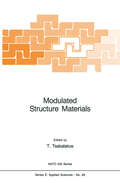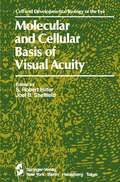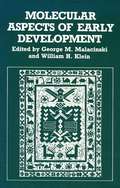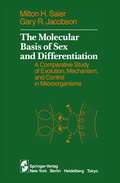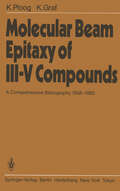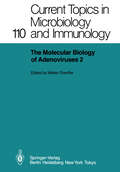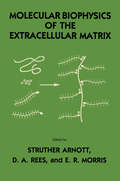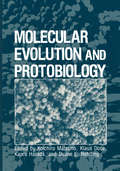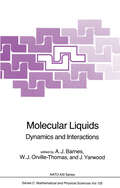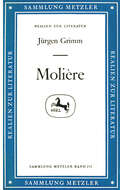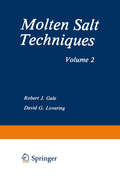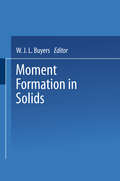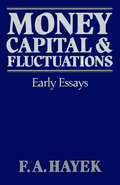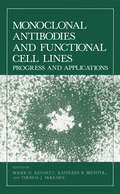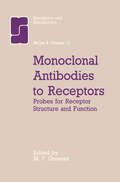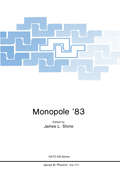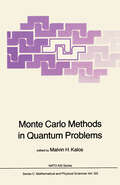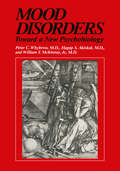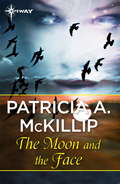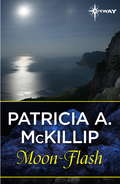- Table View
- List View
Modular Representation Theory: New Trends and Methods (Lecture Notes in Mathematics #1081)
by D. BensonThis reprint of a 1983 Yale graduate course makes results in modular representation theory accessible to an audience ranging from second-year graduate students to established mathematicians. Following a review of background material, the lectures examine three closely connected topics in modular representation theory of finite groups: representations rings; almost split sequences and the Auslander-Reiten quiver; and complexity and cohomology varieties, which has become a major theme in representation theory.
Modulated Structure Materials (NATO Science Series E: #83)
by Thomas TsakalakosProceedings of the NATO Advanced Study Institute on Modulated Structure Materials, Maleme-Chania, Greece, June 15-25, 1983
Molecular and Cellular Basis of Visual Acuity (The Cell and Developmental Biology of the Eye)
by S. R. Hilfer Joel SheffieldThe Seventh Symposium on Ocular and Visual Development was held in October, 1982. The aim of the meeting was to develop a broad perspective on visual acuity. The subject was discussed initially in terms of molecular events of photoreception, and the metabolism of the photoreceptor ele ments. Subsequent papers presented the development and complexity of the neurocircuitry and transmitter systems in the retina that process the visual information prior to transfer to the brain. The meeting concluded with a series of papers on behavioral and physiological methods of mea surement of visual acuity in humans, particularly young children. This volume arose from the papers presented at the meeting. We feel that the juxtaposition of research of broadly differing methodologies will be stim ulating, rather than daunting, and will generate an enhanced understand ing of this complex subject. We are indebted to our colleagues: Dr. M. Mote from Temple University, and Drs. J. Siegfried, P. Dayhaw-Barker, and L. Press from the Pennsylvania College of Optometry for their expertise and assistance in the organization of the meeting; to the speakers for their presentations and contributions to this volume; and to the reviewers of the manuscripts for their helpful comments. This symposium could not have been held without the generous support of the Temple University College of Arts and Sciences and the Pennsyl vania College of Optometry. We also thank Merck, Sharp and Dohme, Inc. for their donation.
Molecular Aspects of Early Development
by George M. Malacinski and William H. KleinThe early embryo has emerged as the focal point for analysis of the regulation of gene expression for several reasons. First, the fact that embryogenesis is under genetic control has been appreciated from the earliest days of classical embryology. When experimental techniques became available it was therefore logical that they should be applied to the embryo. With each new advance in methodology, interest in embryonic gene expression studies has increased. Second, many embryos offer unique opportunities for the investigation of specific aspects of the regulation of gene expression. Several phenomena--eg. , control of translation--can be very conveniently studied in a variety of marine invertebrate embryos. Those embryos contain large stores of maternally inherited mRNA which are translated in a highly ordered fashion during specific stages of post fertilization development. Marine invertebrate eggs can be conveniently artifically inseminated and labeled with radioactive precursors. Their analysis is leading to important insights into the mechanisms which regulate gene expression at post-transcriptional levels. Third, recent advances in both transmission and recombinant DNA genetics, especially in organisms such as Drosophila, are providing special opportunities for the analysis of regulatory mechanisms which operate at the level of the genome. Specific genes have been identified, isolated, and--in some instances--sequenced. The opportunity is now available to study the regulation of the expression of single genes in a vertical fashion--from the primary sequence of the gene to the tissues and organs which are the products of morphogenesis.
The Molecular Basis of Sex and Differentiation: A Comparative Study of Evolution, Mechanism and Control in Microorganisms
by Milton H. Saier Gary R. JacobsonMan's mind stretched to a new idea never goes back to its original dimensions Oliver Wendell Holmes Our current understanding of sex and biological differentiation results from the application of three principal experimental approaches to these subjects: those of the physiologist, the biochemist, and the geneticist. These three approaches are illustrated by the materials presented in the chapters of this volume. Chapters 1-5 emphasize conceptualization of developmental processes, describing systems principally from the standpoint of the physiologist. Structures and functions are defined with only occasional reference to specific molecular details. Chapters 6- 10 present the views of the biochemist, attempting to describe functions influ encing or regulating cellular behavior at the molecular level. And Chapters 11- 14 illustrate the approaches of the modem-day geneticist in his attempts to gain a detailed understanding of processes controlling gene expression. While it is possible to delineate these three major sections, each emphasizing a distinct experimental approach, it must be realized that the yield of knowledge increases exponentially with the number of experimental approaches available to the investigator. Information resulting from the application of each of these approaches must converge to give the same answers for anyone biological phenomenon in anyone experimental system. Further, if we can learn of details regarding a particular process by applying different experimental approaches, our postulates concerning the underlying molecular mechanisms are likely to be more accurate. But biological systems are not unrelated.
Molecular Beam Epitaxy of III–V Compounds: A Comprehensive Bibliography 1958–1983
by K. Ploog K. GrafMolecular Biology and Pathogenesis of Coronaviruses (Advances in Experimental Medicine and Biology #173)
by P. J. RottierThe present volume contains the Proceedings of an EMBO Workshop organized in June 1983 by the Institute of Virology, Veterinary Faculty, State University of Utrecht, The Netherlands. Some 70 scientists from 11 countries followed the invitation to present and discuss their recent data on the structure, replication, genetics and pathogenesis of coronaviruses. It was the second international meeting on these viruses; the Workshop, which was held in Zeist near Utrecht followed the example of the Wuerzburg symposium of October 1980. At that time it became clear that coronaviruses are unique in many respects. Once a group of viruses that were defined merely on the basis of their characteristic peplomer morphology, Coronaviridae family members are known today - to be constructed from essentially three polypeptides - to use a "nested set" of 5-6 subgenomic mRNAs in the expression of their large, positive and single stranded RNA genome, - to generate these subgenomic RNAs through specific fusion of non contiguous sequences, - to mature by budding from intracellular membranes, - to cause persistent infection with neurological involvement and sometimes immunopathological conditons. These and many other findings have been established only very recently. The articles collected in this book reveal and/or further detail these findings. Since these Proceedings contain the combined scientific presentations of representatives from virtually all laboratories engaged in the field, they provide a fairly comprehensive review of the state of the art in corona virology.
The Molecular Biology of Adenoviruses 2: 30 Years of Adenovirus Research 1953–1983 (Current Topics in Microbiology and Immunology #110)
by W. DoerflerThe Molecular Biology of Adenoviruses 3: 30 Years of Adenovirus Research 1953–1983 (Current Topics in Microbiology and Immunology #111)
by W. DoerflerMolecular Biophysics of the Extracellular Matrix (Molecular Biology And Biophysics Ser.)
by Struther Arnott D. A. Rees E. R. MorrisMolecular Evolution and Protobiology
by Koichiro MatsunoIn recent years, an ever-increasing amount of research has been conducted on the physico-chemical basis of the origin and evolution of life, or protobiology. Many questions are raised in this endeavor: What research methodology should be employed? What sort of dependable facts are available as a firm frame of reference upon which the physico-chemical origin of life or protolife could be examined? Is the origin due exclusively to chance events? If not, what is then responsible for the origin? What physical reality underlies the evolutionarily selective process leading to the origin? What role does variation assume and how is it generated in the course of evolution? Many research workers have pursued various avenues toward answering the stated questions. Among them, we believe Sidney W. Fox has been playing a very unique and pivotal role over the past quarter of a century, presiding over 240 man-years or more of labo ratory work. His laboratory syntheses of thermal proteins called proteinoids and proteinoid micro spheres have emphasized the prin ciple of the self-sequencing of amino acids as a key concept of protobiological synthesis. The significance of his contribution is seen in presenting the experimental evidence that the origin of life is largely due to nonrandom events. This discovery marks a new epoch in the conceptual development of studying the origin of life by focusing on the molecular processes that underlied the emergence and evolution of protobiological information.
Molecular Liquids: Dynamics and Interactions (Nato Science Series C: #135)
by A. J Barnes W. J. Orville-Thomas J. YarwoodThis ASI was planned to make a major contribution to the teaching of the principles and methods used in liquid phase ~esearch and to encourage the setting up of collaborative projects, as advocated by the European Molecular Liquids Group (secretary: Dr J. Yarwood, University of Durham, U. K. ). During the past five years considerable progress has been made in studying molecular liquids. The undoubted advantages of international collaboration led to the formation of the European Molecular Liquids Group (EMLG) in July 1981. The activities of the EMLG were widely disseminated in a special session of the European Congress on Molecular Spectroscopy (EUCMOS) held in September 1981 (for details, see J. Mol. Structure, 80 (1982) 375 - 421). Following the success of this meeting, it was thought that the aims and objectives of the E~G would be best served by the organisation of a broader-based gathering designed to attract those interested in the study of the structure, dynamics and interactions in the liquid state. Thanks to the generous support by the Scientific Affairs Division of NATO, it was possible to hold a NATO ASI on Molecular Liquids at the Italian Centre of Stanford University, Florence, Italy during June-July 1983. This book is based on the lectures presented at that meeting. The contents of this volume cover the three broad areas of current liquid phase research: (a) Analytical theory.
Molten Salt Techniques: Volume 2
by Robert J. Gale David G. LoveringThis second volume carries on the excellent work of its predecessor, ex tending its scope to other melts and to other techniques. It continues to present first-hand understanding and experience of this difficult and demanding field. There is ever present the trade-off or reconciliation between the novel chemistry of systems not dominated by the mediating influence of a supposedly indifferent solvent and the high temperatures required to effect the fluidity of the system. At the limit, the very high temperatures so increase the rates of all reactions as to dissolve the temporal difference between the thermodynamic and the kinetic view of chemistry. What can happen will happen and invariably does happen. Vessels corrode, the apparatus becomes a reactant, and the number of tolerant materials able to withstand the attack shrinks to graphite, boron carbide or, if all else fails, to frozen parts of the molten salt itself. It is probably true that there is no limit to man's ingenuity but I believe that God gave us molten salts just to test that thesis. If there is ever a Molten Salt Club, and Englishmen love clubs, its membership will be exclusive. It would certainly include the authors of this series. Graham Hills University of Strathclyde ix Preface In the first volume of this series, we expressed our contention that a real need existed for practical guidance in the field of molten salt experimentation.
Moment Formation In Solids (Nato Science Series B: #117)
by W. J. BuyersThe problem of moment formation in metallic systems lies at the interface of localized and itinerant magnetism. The phenomena observed correspond to destruction rather than to formation of spin-correlations. They give rise to the progression from local ized ground states through Kondo and mixed-valence behaviour to itinerant magnetic or non-magnetic systems. Somewhere in the pro gression superconductivity can occur in the presence of f-moments. To bring together the disparate ideas and methods, previously the subject of intense debate only at a number of topical confer ences, a two-week Advanced Study Institute was held August 21 - September 02, 1983, at Lester B. Pearson College of the Pacific, Vancouver Island. In the stimulating environment provided by the pines and fiord at the site of this remote United World College on the Canadian West Coast, scientists and students from around the globe gathered to hear lectures by experts. The Study Institute involved seventy-six people and followed in the tradition . of pre vious "Banff" summer schools organized by the Canadian Association of Physicists. It was made possible by grants from the North Atlantic Treaty Organization, the Natural Sciences & Engineering Research Council of Canada and Atomic Energy of Canada. The grants permitted many young scientists from Nato and non-Nato countries to learn the fundamentals as well as the latest results in the field.
Money, Capital, and Fluctuations: Early Essays
by F. A. HayekPREFACE AND ACKNOWLEDGMENTS EDITOR'S INTRODUCTION INTRODUCTION 1. THE MONETARY POLICY OF THE UNITED STATES AFTER THE RECOVERY FROM THE 1920 CRISIS (1925) 2. SOME REMARKS ON THE PROBLEM OF IMPUTATION (1926) 3. ON THE PROBLEM OF THE THEORY OF INTEREST (1927) 4. INTERTEMPORAL PRICE EQUILIBRIUM AND MOVEMENTS IN THE VALUE OF MONEY (1928) 5. THE FATE OF THE GOLD STANDARD (1932) 6. CAPITAL CONSUMPTION (1932) 7. ON 'NEUTRAL MONEY' (1933) 8. TECHNICAL PROGRESS AND EXCESS CAPACITY (1936) Two reviews MARGINAL UTILITY AND ECONOMIC CALCULATION (1925) THE EXCHANGE VALUE OF MONEY (1929) NAME INDEX
Money, Capital, and Fluctuations: Early Essays
by F. A. HayekPREFACE AND ACKNOWLEDGMENTS EDITOR'S INTRODUCTION INTRODUCTION 1. THE MONETARY POLICY OF THE UNITED STATES AFTER THE RECOVERY FROM THE 1920 CRISIS (1925) 2. SOME REMARKS ON THE PROBLEM OF IMPUTATION (1926) 3. ON THE PROBLEM OF THE THEORY OF INTEREST (1927) 4. INTERTEMPORAL PRICE EQUILIBRIUM AND MOVEMENTS IN THE VALUE OF MONEY (1928) 5. THE FATE OF THE GOLD STANDARD (1932) 6. CAPITAL CONSUMPTION (1932) 7. ON 'NEUTRAL MONEY' (1933) 8. TECHNICAL PROGRESS AND EXCESS CAPACITY (1936) Two reviews MARGINAL UTILITY AND ECONOMIC CALCULATION (1925) THE EXCHANGE VALUE OF MONEY (1929) NAME INDEX
Monoclonal Antibodies and Functional Cell Lines: Progress and Applications
by Roger H. KennettThis volume serves as a follow-up to our previous book, MonoclonalAntibodies Hybridomas: A New Dimension in Biological Analyses. We continue the theme of monoclonal antibodies and their applications, attempting to cover some of the areas not covered in the previous volume. We again include an appendix de scribing methods useful to those who ar-e beginning to apply these techniques in their own laboratories. This volume will be followed by another concentrating on the combination of monoclonal antibody techniques with molecular genetic techniques to study structure/function relationships at the level of both the gene and gene product. Roger H. Kennett Kathleen B. Bechtol Philadelphia, Pennsylvania Thomas J. McKearn Princeton, New Jersey IX Acknowledgments Roger Kennett acknowledges the patience and support of his wife, Carol, and his family, friends, and colleagues during the work on this volume, and again thanks, above all, the Lord, Jesus Christ. Kathleen Bechtol wishes to thank colleagues and friends for their support and understanding during the months of preparation of this volume. Tom McKearn acknowledges and thanks his wife, Pat, and his family for their support and encouragement. Xl Contents PART I INTRODUCTION 1 Introduction: Reflections on Nine Years of Monoclonal Antibodies from Hybridomas 3 ROGER H. KENNETT, KATHLEEN B. BECHTOL, AND THOMAS J. McKEARN 1. Biotechnology'S "Coming of Age". . . . . . . . . . . . . . . . . . . . . . . . . . . . . . . . . . . . . . . . . . . . . . . 3 II. Monoclonal Antibodies-An Overview of Applications. . . . . . . . . . . . . . . . . . . . . . . . . . . . 6 III. Commercialization of Monoclonal Antibody Technology.. . . .. ... . .... .... .. . ... . . 10 References. . . . . . . . . . . . . . . . . . . . . . . . . . . . . . . . . . . . . . . . . . . . . . . 13 . . . . . . . . . . . . . . . . . . . . .
Monoclonal Antibodies to Receptors: Probes for Receptor Structure and Funtcion (Receptors and Recognition #17)
by M. F. GreavesMonopole ’83 (Nato Science Series B: #111)
by James L. StoneTen years have passed since It Hooft and Polyakov demonstrat ed that superheavy magnetic monopoles were a natural consequence of any Grand Unified Theory (GUT) in which the unifying group contains a U(l) factor as a subgroup. An analysis of these GUTs in an expanding, cooling universe yields a phase transition at an energy ~l015 GeV and at a cosmic time ~lO-35 seconds after the big bang. The general consequences of GUTs and this phase transition are the prediction of proton decay, the production of superheavy magnetic monopoles, and an understanding of the observed excess of matter over anti-matter in the universe. Attempts to provide experimental verification of GUTs has led to valiant experimental efforts in recent years to observe nucleon decay in massive underground detectors. Experiments to search for superheavy monopoles may eventually require similar efforts. Since the unification scale is unreachable in the laboratory, monopole detectors must search for relics of the big bang. Much theoretical groundwork has been accomplished in recent years with the development of GUTs. In Part I of this book, Erick Weinberg gives a theoretical overview of the role of magnetic monopoles in the various unification schemes. Monopoles in the context of the newly revived Kaluza-Klein theories are presented by several authors and are summarized by Qaisar Shafi. Mike Turner begins Part II with a discussion of monopoles in standard big bang cosmology. Paul Steinhardt follows with his perspectives on the inflationary universe; C.
Monte Carlo Methods in Quantum Problems (Nato Science Series C: #125)
by M. H. KalosMonte Carlo methods have been a tool of theoretical and computational scientists for many years. In particular, the invention and percolation of the algorithm of Metropolis, Rosenbluth, Rosenbluth, Teller, and Teller sparked a rapid growth of applications to classical statistical mechanics. Although proposals for treatment of quantum systems had been made even earlier, only a few serious calculations had heen carried out. Ruch calculations are generally more consuming of computer resources than for classical systems and no universal algorithm had--or indeed has yet-- emerged. However, with advances in techniques and in sheer computing power, Monte Carlo methods have been used with considerable success in treating quantum fluids and crystals, simple models of nuclear matter, and few-body nuclei. Research at several institutions suggest that they may offer a new approach to quantum chemistry, one that is independent of basis ann yet capable of chemical accuracy. That. Monte Carlo methods can attain the very great precision needed is itself a remarkable achievement. More recently, new interest in such methods has arisen in two new a~as. Particle theorists, in particular K. Wilson, have drawn attention to the rich analogy between quantum field theoty and statistical mechanics and to the merits of Monte Carlo calculations for lattice gauge theories. This has become a rapidly growing sub-field. A related development is associated with lattice problems in quantum physics, particularly with models of solid state systems. The~ is much ferment in the calculation of various one-dimensional problems such as the'Hubbard model.
Mood Disorders: Toward a New Psychobiology (Critical Issues in Psychiatry)
by Peter C. Whybrow Hagop S. Akiskal William T. McKinney Jr.In this book we present a conceptually integrated approach to disorders of mood. These disorders are defined narrowly as the clinical syndromes of mania and melancholia. The latter is our particular focus, for the simple reason that it is more common and thus more is known about it. Our approach owes much to Adolf Meyer, who first used the term psychobiology. It was he who emphasized in a practical way the importance of the clinician consider ing the joint contribution of psychosocial and biological factors in the genesis of mental disorders. However, until the 1960s, our relative ignorance of basic mechanisms that link brain and behavior prevented the development of a genuine psychobiological perspective. Thus Meyer's work was concerned largely with teaching the importance of the personal biography and a consideration of social history in the development of mental disorder. We feel that sufficiently rigorous data have now emerged in psychia try to permit tentative but real psychobiological integration. Affective illness is proba bly the most promising area for an attempt at such a synthesis. It is our belief that the theory and clinical practice of psychiatry now can be woven into a coherent theme, integrating insights and evidence generated by the psychodynamic, biological, and behavioral methods; hence in part we review the emerging psychobiology of mood disorders with the hope that it can serve as a generic paradigm for other psychiatric syndromes.
The Moon and the Face
by Patricia A. MckillipRiverworld was a planet of Eden whose people possessed the power of dreaming the future. Kyreol, daughter of a Healer, pierced the vision veil to discover the ultimate truth - that her home world unknowingly hosted the way station of a vast interstellar civilisation. An evil star shone on Kyreol's first mission as an interplanetary agent. Her ship fell out of space, cracking on a lonely, mysterious moon. Rising from its endless plains was the white city - awesome, abandoned, eons-dead - a silent world of secret wonders. Only her prophetic dreams linked Kyroel to Riverworld, but she was hopelessly marooned light-years away. And she was not alone...
Moon-Flash
by Patricia A. McKillipKyreol's small world begins at the Face, a high rock cliff, and ends at Fourteen Falls, a series of rapids. Each year, her people celebrate Moon-Flash-a spark of light that seems to come from and go into the moon, a symbol of life and joy. When a mysterious stranger arrives, Kyreol wants to know more about him, as well as the Moon-Flash, and soon she and her childhood friend Terje leave their home to look for answers. Those answers will pluck Kyreol from Riverworld and transform her life forever-by fast-forwarding her into a future she can barely comprehend.

